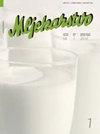总固形物不同标准化方法对酸奶中矿物质含量的影响
IF 1.1
4区 农林科学
Q3 AGRICULTURE, DAIRY & ANIMAL SCIENCE
引用次数: 1
摘要
酸奶是含有大量和微量矿物质的良好膳食来源。然而,酸奶的矿物质含量可能因其生产过程中使用的工艺而有所不同。在此背景下,本研究的目的是通过以下四种不同的方法比较总固体标准化酸奶中的一些宏观(Ca、K和Mg)和微观(As、Cd、Co、Fe、Mn、Ni、Pb、Se、V和Zn)矿物质含量:(1)在牛奶中添加脱脂奶粉,(3)在布袋中浓缩酸奶凝乳和(4)通过机械离心浓缩酸奶凝乳。用方法1生产的酸奶中宏观矿物质含量最高,而用方法4生产的酸奶大多数微观矿物质含量最高。本研究的结果表明,用酸奶生产中使用的方法可以改变酸奶的矿物质含量,以标准化总固体含量。本文章由计算机程序翻译,如有差异,请以英文原文为准。
Effect of total solids standardization using different methods on mineral content of yoghurt
Yoghurt is a good dietary source of macro and micro minerals. However, the mineral content of yoghurt can vary according to the technological processing used in its manufacture. In this context, the aim of this study was to compare some macro (Ca, K and Mg) and micro (As, Cd, Co, Fe, Mn, Ni, Pb, Se, V and Zn) mineral contents of total solids-standardized yoghurts with four different methods by following: (1) Addition of skim milk powder to milk, (2) Concentration of yoghurt milk by vacuum evaporation, (3) Concentration of yoghurt curd in a cloth bag and (4) Concentration of yoghurt curd by mechanical centrifugation. The highest content of the macro minerals was in the yoghurt produced with method 1, while the highest content of most of the micro minerals was in the yoghurt produced with method 4. The results of this study showed that the mineral content of yoghurt could be modified by the method used in the manufacture of yoghurt to standardize total solids content.
求助全文
通过发布文献求助,成功后即可免费获取论文全文。
去求助
来源期刊

Mljekarstvo
Agricultural and Biological Sciences-Animal Science and Zoology
CiteScore
1.90
自引率
41.70%
发文量
18
审稿时长
12 weeks
期刊介绍:
Mljekarstvo is an open access, peer-reviewed international quarterly scientific journal. The first issue was published in 1951, by the Croatian Dairy Operators'' Association (today: Croatian Dairy Union, publisher). In a paper at a Union conference held 28 October 1951 in Zagreb it was said: "Our desire is that this magazine does not meet the fate of its predecessors, but that it continues to reflect the creative efforts and to provide guidelines for the producers as well as all other operators employed in the dairy industry."
It is our pleasure today to say that wishes of the enthusiasts who attended the conference have come true, and the magazine Mljekarstvo during the last six decades was a reflection of the creative efforts of numerous dairy scientists and experts, and through its texts it served as a guideline in improving production and processing of milk and dairy products. Mljekarstvo has been following all the achievements of the dairy profession in Croatia, and it also gives the short surveys of world achievements. The result of the research of local and foreign scientists and experts always find their place in the magazine Mljekarstvo. It has been edited by our outstanding dairy experts employed at colleges, research institutions and dairy companies.
 求助内容:
求助内容: 应助结果提醒方式:
应助结果提醒方式:


